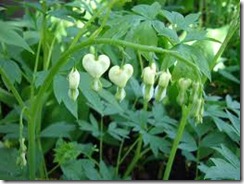Bleeding Heart (Dicentra) is a flowering plant that is native to Japan. Its compound leaves are deeply cut and resemble fern leaves. The leaves unfurl in early spring, and the flowers follow in mid spring. Blossoms are uniquely heart-shaped, and are borne along drooping stems. Bleeding heart flowers come in all shades of pinks, with some varieties nearly red and others pure white. The plants can grow up to three feet tall and three to four feet in diameter.
Shade-Loving Plants
-
Bleeding hearts thrive in deeply shaded areas. Plant them in a shade garden or along the edge of a woods. The north side of a building is another good location. Some varieties will tolerate partial day light sun. Bleeding Hearts are a good choice for naturalizing woodland gardens.
The flowering period can last for several weeks, from first opening in mid spring often until mid summer. Trim off spent flower stalks, and when the weather stays cool the plants will send forth more blooms. If you leave the flower stalks, they will form small pods with seeds that will be dispersed when the pods dry and break open. Foliage turns yellow and dies back in the summer heat. Trim it any time it becomes unsightly.
Planting and Propagation
-
Prepare your planting area by spreading a one-inch layer of compost. Mix it into the soil well.
Bleeding hearts are often sold in the spring as potted plants. Plant them at the same depth they are growing in the pot, and water them in to set the soil around the plant.
Root divisions are sold in early spring and fall. A root division should include fleshy portions that are not wrinkled or dried out. If you find springtime root divisions with a small green shoot beginning to grow, you’ll know the root is viable. Plant the root in your prepared area so that the green shoot is at the soil level and water it in.
You can divide your existing Bleeding Heart to make your own transplants. Do this in the spring or fall. In the spring, make a clump about six inches in diameter and include leaves and flower stems. Set the clump in its new spot at the same depth it was growing, and water it in. Fall divisions should be made about six weeks before your first expected frost, so the clumps have time to establish roots before a winter freeze. Fall divisions usually have foliage that is dying back, and you can trim it off when you transplant the clump.
Watering
-
Bleeding Hearts like plenty of water, but they need well-drained soil. Water them frequently to keep the soil moist; try not to let it dry out between watering. Root rot or fungus infections will develop if the soil is soggy. Improve the soil drainage by adding humus.
Fertilizer
-
Bleeding Hearts prefer a well-balanced fertilizer. A side dressing of compost every three to four weeks provides this. (To side dress, simply spread a layer of compost around the plant and lightly work it into the very top of the soil without disturbing the roots.)
Fish emulsion is an excellent organic fertilizer, and it is easy to mix and apply during your regular watering routine.


Deprecated: strpos(): Passing null to parameter #1 ($haystack) of type string is deprecated in /home/agriviek8Qv/agriviet.net/public_html/wp-includes/comment-template.php on line 2522